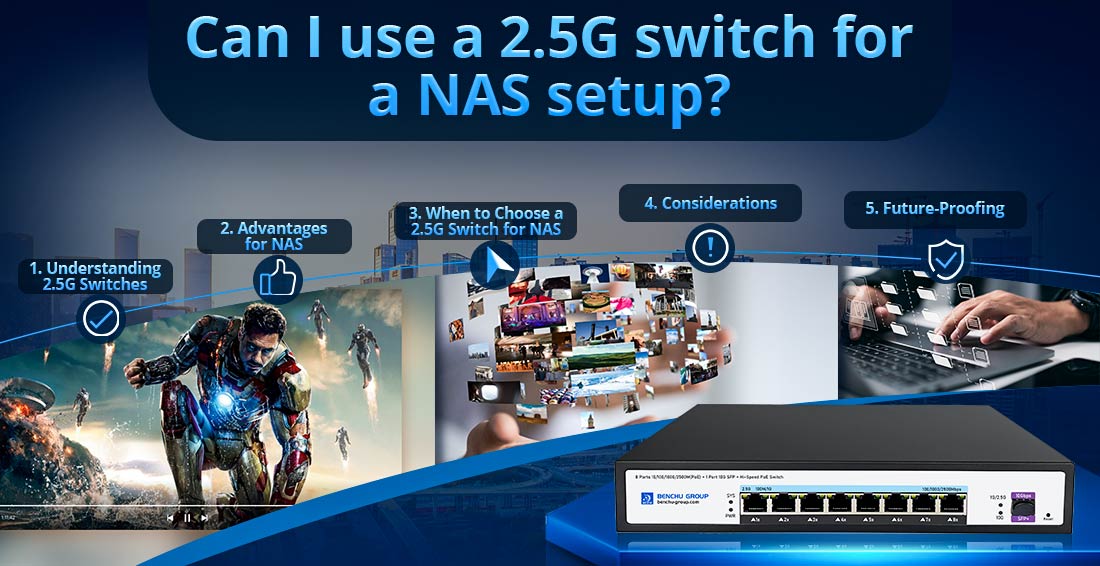
Oui, vous pouvez utiliser un commutateur 2,5G pour une configuration NAS (Network Attached Storage), et il peut offrir plusieurs avantages par rapport à un commutateur Gigabit (1G) classique, notamment en ce qui concerne des vitesses de transfert de données plus rapides. Voici une explication détaillée :
1. Comprendre les commutateurs 2,5G
A Commutateur 2,5G fait référence à un commutateur qui prend en charge des vitesses réseau de 2,5 Gbit/s par port, soit 2,5 fois plus rapide que les ports standard de 1 Gbit/s que l'on trouve dans la plupart des commutateurs grand public. Il sert de compromis entre les commutateurs 1G et 10G, offrant des vitesses plus rapides à un prix plus abordable que les solutions 10G.
2. Avantages pour le NAS
L'utilisation d'un commutateur 2,5G dans une configuration NAS peut améliorer considérablement les performances, surtout si votre périphérique NAS et d'autres périphériques réseau (comme votre ordinateur ou votre routeur) prennent en charge les connexions Ethernet 2,5G. Voici comment procéder :
Transferts de données plus rapides : si votre NAS prend en charge un port Ethernet 2,5G, vous pourrez bénéficier de transferts de fichiers plus rapides, en particulier pour les fichiers volumineux tels que les sauvegardes, les fichiers multimédias (vidéos, photos) ou les données professionnelles. Cela réduit le temps nécessaire pour copier ou déplacer des fichiers vers et depuis votre NAS.
--- Streaming plus fluide et performances multi-utilisateurs : pour les configurations dans lesquelles plusieurs utilisateurs accèdent simultanément au NAS (par exemple, un bureau à domicile ou une petite entreprise), un commutateur 2,5G peut gérer plus efficacement les demandes de bande passante plus élevées. Ceci est particulièrement utile pour des tâches telles que la diffusion de vidéos 4K, l'édition en temps réel de fichiers volumineux ou l'exécution de plusieurs processus de sauvegarde à la fois.
--- Performances améliorées dans les PME : dans les petites et moyennes entreprises (PME), où les systèmes NAS peuvent être utilisés pour la sauvegarde de données, le partage de fichiers ou comme serveur multimédia, un réseau 2,5G peut améliorer les performances globales du réseau. réduisant les goulots d'étranglement causés par les commutateurs 1G traditionnels.
3. Quand choisir un commutateur 2,5G pour NAS
Un switch 2,5G est idéal dans les cas suivants :
--- Votre NAS et vos appareils prennent en charge Ethernet 2,5G : assurez-vous que votre NAS et les appareils connectés (PC, serveurs, etc.) disposent de ports Ethernet 2,5G pour utiliser pleinement les avantages d'un commutateur 2,5G.
--- Vous transférez fréquemment des fichiers volumineux : si vous travaillez avec des vidéos haute résolution, des sauvegardes volumineuses ou des fichiers de conception 3D, les vitesses 2,5G seront considérablement bénéfiques.
--- Vous avez un nombre croissant d'utilisateurs ou d'appareils accédant au NAS : la bande passante accrue permet de mieux gérer plusieurs utilisateurs ou appareils accédant aux données sur le NAS en même temps.
4. Considérations
Compatibilité descendante : La plupart des commutateurs 2,5G sont rétrocompatibles avec les appareils 1G et même 100 Mbps, vous n'aurez donc pas besoin de remplacer tous les appareils réseau en même temps. Vous pouvez progressivement passer à des appareils compatibles 2,5G.
Exigences de câblage : L'Ethernet 2,5G est conçu pour fonctionner avec les câbles Cat5e et Cat6 existants, vous n'aurez donc probablement pas besoin de mettre à niveau votre câblage, sauf si vous envisagez de passer à des vitesses 10G.
Prise en charge des modèles NAS : Tous les appareils NAS ne sont pas équipés de ports 2,5G, alors assurez-vous que votre modèle de NAS le prend en charge ou peut être mis à niveau avec une carte réseau 2,5G (carte d'interface réseau).
5. Pérennité
--- Un commutateur 2,5G est un moyen rentable de pérenniser votre réseau. Même si votre NAS ou d'autres périphériques réseau ne prennent actuellement en charge que 1G, la mise à niveau vers un commutateur 2,5G garantit que vous êtes prêt pour les futures mises à niveau vers des périphériques NAS ou des ordinateurs plus rapides.
Conclusion
L'utilisation d'un commutateur 2,5G pour votre configuration NAS peut offrir des performances améliorées, en particulier dans les environnements où les transferts de fichiers rapides, le streaming multimédia ou l'accès multi-utilisateurs sont essentiels. Il s'agit d'un excellent choix pour les utilisateurs particuliers et les petites entreprises qui cherchent à améliorer les performances de leur réseau sans avoir à passer directement à une configuration 10G complète.